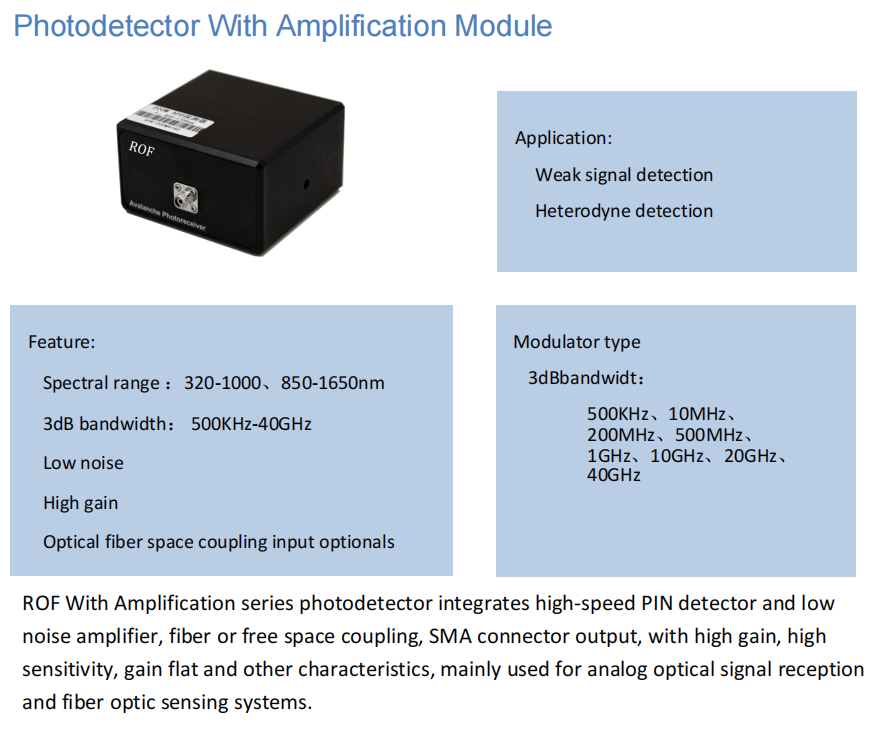News
The effect of high-power silicon carbide diode on PIN Photodetector
2024-04-09 09:40:33 | Company News Page views:549
The effect of high-power silicon carbide diode on PIN Photodetector
High-power silicon carbide PIN diode has always been one of the hotspots in the field of power device research. A PIN diode is a crystal diode constructed by sandwiching a layer of intrinsic semiconductor (or semiconductor with low concentration of impurities) between the P+ region and the n+ region. The i in PIN is an English abbreviation for the meaning of "intrinsic", because it is impossible to exist a pure semiconductor without impurities, so the I layer of the PIN diode in the application is more or less mixed with a small amount of P-type or N-type impurities. At present, the silicon carbide PIN diode mainly adopts Mesa structure and plane structure.
When the operating frequency of PIN diode exceeds 100MHz, due to the storage effect of a few carriers and the transit time effect in layer I, the diode loses the rectification effect and becomes an impedance element, and its impedance value changes with the bias voltage. At zero bias or DC reverse bias, the impedance in I region is very high. In DC forward bias, the I region presents a low impedance state due to carrier injection. Therefore, the PIN diode can be used as a variable impedance element, in the field of microwave and RF control, it is often necessary to use switching devices to achieve signal switching, especially in some high-frequency signal control centers, PIN diodes have superior RF signal control capabilities, but also widely used in phase shift, modulation, limiting and other circuits.
High-power silicon carbide diode is widely used in power field because of its superior voltage resistance characteristics, mainly used as high-power rectifier tube. The PIN diode has a high reverse critical breakdown voltage VB, due to the low doping i layer in the middle carrying the main voltage drop. Increasing the thickness of zone I and reducing the doping concentration of zone I can effectively improve the reverse breakdown voltage of the PIN diode, but the presence of zone I will improve the forward voltage drop VF of the entire device and the switching time of the device to a certain extent, and the diode made of silicon carbide material can make up for these deficiencies. Silicon carbide 10 times the critical breakdown electric field of silicon, so that the silicon carbide diode I zone thickness can be reduced to one-tenth of the silicon tube, while maintaining a high breakdown voltage, coupled with the good thermal conductivity of silicon carbide materials, there will be no obvious heat dissipation problems, so high-power silicon carbide diode has become a very important rectifier device in the field of modern power electronics.
High-power silicon carbide PIN diode has always been one of the hotspots in the field of power device research. A PIN diode is a crystal diode constructed by sandwiching a layer of intrinsic semiconductor (or semiconductor with low concentration of impurities) between the P+ region and the n+ region. The i in PIN is an English abbreviation for the meaning of "intrinsic", because it is impossible to exist a pure semiconductor without impurities, so the I layer of the PIN diode in the application is more or less mixed with a small amount of P-type or N-type impurities. At present, the silicon carbide PIN diode mainly adopts Mesa structure and plane structure.
When the operating frequency of PIN diode exceeds 100MHz, due to the storage effect of a few carriers and the transit time effect in layer I, the diode loses the rectification effect and becomes an impedance element, and its impedance value changes with the bias voltage. At zero bias or DC reverse bias, the impedance in I region is very high. In DC forward bias, the I region presents a low impedance state due to carrier injection. Therefore, the PIN diode can be used as a variable impedance element, in the field of microwave and RF control, it is often necessary to use switching devices to achieve signal switching, especially in some high-frequency signal control centers, PIN diodes have superior RF signal control capabilities, but also widely used in phase shift, modulation, limiting and other circuits.
High-power silicon carbide diode is widely used in power field because of its superior voltage resistance characteristics, mainly used as high-power rectifier tube. The PIN diode has a high reverse critical breakdown voltage VB, due to the low doping i layer in the middle carrying the main voltage drop. Increasing the thickness of zone I and reducing the doping concentration of zone I can effectively improve the reverse breakdown voltage of the PIN diode, but the presence of zone I will improve the forward voltage drop VF of the entire device and the switching time of the device to a certain extent, and the diode made of silicon carbide material can make up for these deficiencies. Silicon carbide 10 times the critical breakdown electric field of silicon, so that the silicon carbide diode I zone thickness can be reduced to one-tenth of the silicon tube, while maintaining a high breakdown voltage, coupled with the good thermal conductivity of silicon carbide materials, there will be no obvious heat dissipation problems, so high-power silicon carbide diode has become a very important rectifier device in the field of modern power electronics.
Because of its very small reverse leakage current and high carrier mobility, silicon carbide diodes have great attraction in the field of photoelectric detection. Small leakage current can reduce the dark current of the detector and reduce noise; High carrier mobility can effectively improve the sensitivity of silicon carbide PIN detector(PIN Photodetector). The high-power characteristics of silicon carbide diodes enable PIN detectors to detect stronger light sources and are widely used in the space field. High power silicon carbide diode has been paid attention to because of its excellent characteristics, and its research has also been greatly developed.





















